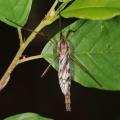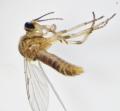Diptera.info :: Identification queries :: Diptera (adults)
Who is here? 1 guest(s)
|
Tabanus bifarius?
|
|
| Nikita Vikhrev |
Posted on 12-06-2006 15:08
|
|
Member Location: Moscow, Russia Posts: 9399 Joined: 24.05.05 |
Moscow region, 10 june, 16-17mm
Nikita Vikhrev attached the following image:  [95.61Kb] Nikita Vikhrev - Zool Museum of Moscow University |
|
|
|
| Zeegers |
Posted on 12-06-2006 20:18
|
|
Member Location: Soest, NL Posts: 18902 Joined: 21.07.04 |
Hi Nikita Nice picture, wrong genus ! It is a male of Hybomitra bimaculata. I agree, difficult to see in the picture. Tabanini-Horseflies with banded hairy eyes around Moscow are bound to be Hybomitra. Theo Zeegers |
|
|
|
| Nikita Vikhrev |
Posted on 12-06-2006 22:30
|
|
Member Location: Moscow, Russia Posts: 9399 Joined: 24.05.05 |
Excuse me Theo, it was my first attempt to ID Tabanidae and I was sure that all flies looking like "trivial horse-fly" belong to genus Tabanus. And Hybomitra I thought is somethink rather exotic. Well, first step to learn is to know what you don't know. Thank you. Nikita Vikhrev - Zool Museum of Moscow University |
|
|
|
| Zeegers |
Posted on 13-06-2006 17:57
|
|
Member Location: Soest, NL Posts: 18902 Joined: 21.07.04 |
There's no reason to excuse yourself for a mistake. And Hybomitra is in the forests and marshes around Moscow much more common that Tabanus, especially in springtime. This one, H. bimaculata, probably one of the most common Good luck with the others Theo |
|
|
|
| Kahis |
Posted on 13-06-2006 21:16
|
|
Member Location: Helsinki, Finland Posts: 1999 Joined: 02.09.04 |
Zeegers wrote: And Hybomitra is in the forests and marshes around Moscow much more common that Tabanus, especially in springtime. This one, H. bimaculata, probably one of the most common Theo I'd say! Here in Finland Hybomitra bimaculata is literally painfully common at times. The only other large tabanid that comes close is H. nitidifrons mostly on and around peat bogs. All other Hybomitra & Tabanus species are usually present in low numbers if at all. Kahis |
| Zeegers |
Posted on 13-06-2006 21:31
|
|
Member Location: Soest, NL Posts: 18902 Joined: 21.07.04 |
Oke two tips -1) don't think too soon: that Hybomitra is the same. there are many similar species. You both can find bimaculata, muehlfeldi, ciureai, nitidifrons, lurida, tarandina, montanan, lundbecki and tropica, to name a few. -2) Look for hovering males ! Hovering males are easily found, when present, and should belong to muehlfeldi, lundbecki or arpadi (sorry, forgot arpadi in 1). Good luck theo |
|
|
|
| Nikita Vikhrev |
Posted on 13-06-2006 21:43
|
|
Member Location: Moscow, Russia Posts: 9399 Joined: 24.05.05 |
to Theo: I have excused because I immidatly found that it is realy easy to distinguish genuses Hybomitra and Tabanus and I have enought expirience to do it myself instead of clear misID in a hurry. The only real excuse is that having a task to make maximaly full insecta/diptera gallery I havn't time for both photografing and serios work with keys. to Kahis: What is realy unusual this year in Moscow region is almost total absence of Culicidae. I do not remember summer like this during all my life! Nikita Vikhrev - Zool Museum of Moscow University |
|
|
|
| Xespok |
Posted on 14-06-2006 09:17
|
|
Member Location: Debrecen, Hungary Posts: 5551 Joined: 02.03.05 |
Nikita Vikhrev wrote: What is realy unusual this year in Moscow region is almost total absence of Culicidae. I do not remember summer like this during all my life! They all seem to be here in Hungary. We are having an exceptional cold and wet summer, and there were several waves of floods in Hungary, which has increased the mosquito load to plague proportions. Up to 10% of the deer populaton has been wiped out in some areas by the mosquito swarms! The mosquito plague has changed the deer behaviour completely, and forced these otherwise shy animals out of the forests to more open agricultural land. |
| Susan R Walter |
Posted on 14-06-2006 13:21
|
|
Member Location: Touraine du Sud, central France Posts: 1802 Joined: 14.01.06 |
I collected something that looks remarkably similar sheltering under the external frame of my kitchen window this morning. I haven't had a chance to look at it properly, but it is at least as big as Nikita's specimen (possibly larger), with a row of very white spots down the centre of the abdomen. We live very close to a large area of marshland. I am having similar time management problems as Nikita - my fridge is rapidly filling with flies I don't have time to do anything more with. We have guests at the moment, who are 'manfully' ignoring the flies in the cheese compartment and on the top shelf. At what stage is it recommended to get a separate fridge for the wildlife? Xespok's information about the deer is really fascinating. We have also had an extremely cold and wet May, but have just had the hottest June days on record in southern England. I was in Suffolk, studying some of the opposition (bumblebees) for my university course - would you believe it - it was too hot for them and we struggled to get a good range of species. Susan |
| Jump to Forum: |
















